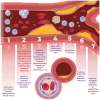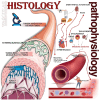Glycolipid Metabolic Disorders, Metainflammation, Oxidative Stress, and Cardiovascular Diseases: Unraveling Pathways
- PMID: 39056712
- PMCID: PMC11273409
- DOI: 10.3390/biology13070519
Glycolipid Metabolic Disorders, Metainflammation, Oxidative Stress, and Cardiovascular Diseases: Unraveling Pathways
Abstract
Glycolipid metabolic disorders (GLMDs) are various metabolic disorders resulting from dysregulation in glycolipid levels, consequently leading to an increased risk of obesity, diabetes, liver dysfunction, neuromuscular complications, and cardiorenal vascular diseases (CRVDs). In patients with GLMDs, excess caloric intake and a lack of physical activity may contribute to oxidative stress (OxS) and systemic inflammation. This study aimed to review the connection between GLMD, OxS, metainflammation, and the onset of CRVD. GLMD is due to various metabolic disorders causing dysfunction in the synthesis, breakdown, and absorption of glucose and lipids in the body, resulting in excessive ectopic accumulation of these molecules. This is mainly due to neuroendocrine dysregulation, insulin resistance, OxS, and metainflammation. In GLMD, many inflammatory markers and defense cells play a vital role in related tissues and organs, such as blood vessels, pancreatic islets, the liver, muscle, the kidneys, and adipocytes, promoting inflammatory lesions that affect various interconnected organs through their signaling pathways. Advanced glycation end products, ATP-binding cassette transporter 1, Glucagon-like peptide-1, Toll-like receptor-4, and sphingosine-1-phosphate (S1P) play a crucial role in GLMD since they are related to glucolipid metabolism. The consequences of this is system organ damage and increased morbidity and mortality.
Keywords: atherogenesis; cardiovascular diseases; dyslipidemia; glycolipid metabolic disorders; hyperglycemia; metainflammation; oxidative stress.
Conflict of interest statement
The authors declare no conflicts of interest.
Figures






References
-
- Tiwari A., Balasundaram P. StatPearls. Ineligible Companies; Treasure Island, FL, USA: 2024. Public Health Considerations Regarding Obesity. Disclosure: Palanikumar Balasundaram declares no relevant financial relationships with ineligible companies. - PubMed
-
- Sheer A.J., Lo M.C. StatPearls. Ineligible Companies; Treasure Island, FL, USA: 2024. Counseling Patients With Obesity. Disclosure: Margaret Lo declares no relevant financial relationships with ineligible companies. - PubMed
Publication types
LinkOut - more resources
Full Text Sources

